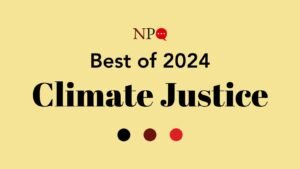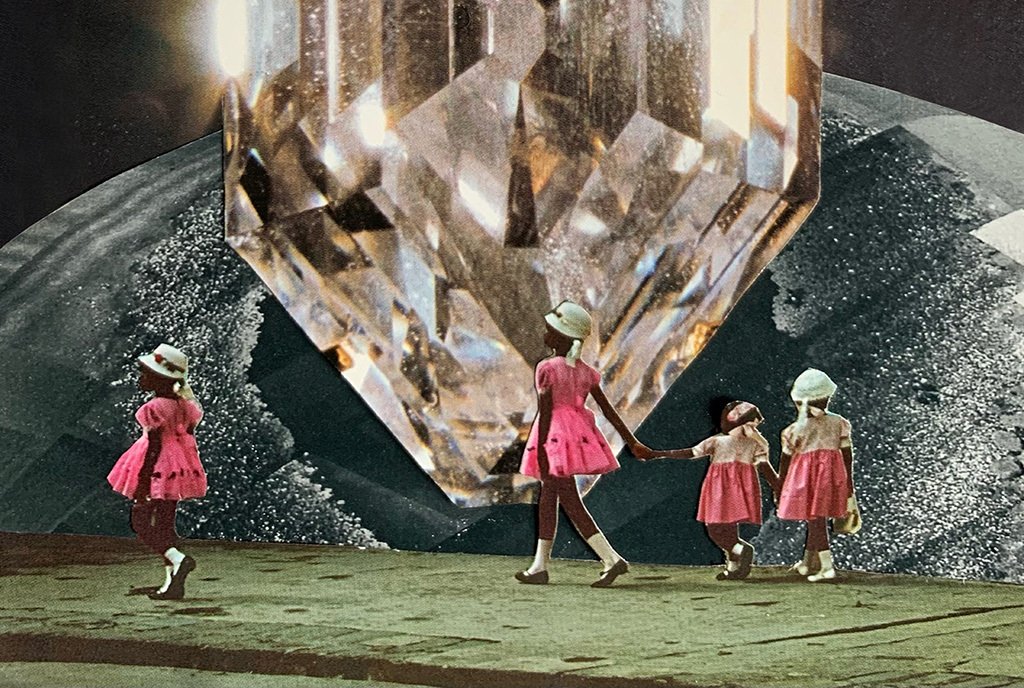
Editors’ note: This article is from Nonprofit Quarterly Magazine’s fall 2023 issue, “How Do We Create Home in the Future? Reshaping the Way We Live in the Midst of Climate Crisis.”
It’s 2075. Everyone has the energy they need to survive and thrive. Our homes can withstand the bitter cold and extreme heat, and no one gets sick or dies prematurely for lack of affordable energy. The energy we all receive to survive and thrive comes from regenerative sources—which have mitigated the worst of planetwide warming and weather extremes. Billions of dollars in energy infrastructure and its associated profits are no longer hoarded by a handful of wealthy investors, utility executives, and shareholders; instead, they are deployed for shared prosperity to eliminate the racial wealth divide and to create meaningful, joyous, living-wage work for those formerly excluded from the economy. Moreover, a significant proportion of utility governing boards comprises utility workers and frontline community members. Energy is increasingly managed as part of a broader commons, where resources and land are shared and mineral inputs to renewable energy and storage like lithium and cobalt are minimized.1 While all more frequent and severe, heat waves, droughts, fires, and flooding no longer knock out our power for longer than a few hours at a time; and when they do, our backup distributed generation and storage systems power us through the gap.
Energy and utility justice movements aren’t just imagining versions of this future but also are actively working to build them; yet the formidable power structures of the electric and gas utility system often stand in the way. These structures go beyond the physical infrastructure of poles, wires, and pipes to encompass the culture, laws, institutions, and power structures that shape who gets to live today and who gets to live—and even thrive—in the coming decades.2
Today’s Utility System Disparities
Deploying new climate technologies with century-plus-old unjust laws, regulations, and practices… poses a high risk that existing disparities will be locked in for another century while the root power, race, and capital imbalances fueling the climate crisis go unaddressed.
So far, electric and gas utilities have not just fueled the climate crisis but also generated very uneven health, wealth, and access outcomes, which include the following:
- Rampant use of utility shutoffs for unaffordable bills, which leads to major economic and health harms, and even shortened lives—disproportionately for communities of color, the elderly, and the poor. The Red Nation has posed the question, Is a house without heat, water, or electricity really a “home?”3 Utilities postpandemic have resumed their daily practice of shutting off life-sustaining power to households simply for their inability to afford it. “[D]uring the first ten months of 2022,…an estimated 4.2m” households were shut off from their energy utilities, affecting nearly 11 million families—or 3 percent of all US households.4 Beyond shutting off access to power, heating, and cooling for nonpayment, utilities place liens on such properties that are not dischargeable in bankruptcy, charge late fees, and then charge reconnection fees—piling on additional penalties beyond the direct harm of the shutoff.
- Major disparities in the capacity of distribution system infrastructure—the poles, wires, and transformers that encompass the final stage of electricity delivery. Frontline organizations in Michigan have called these disparities in capacity on the distribution system “utility redlining,” following a study showing that utility infrastructure is often more vulnerable to outages in lower-income communities of color.5 Researchers in California found similar trends, noting these distribution disparities also make it more costly and challenging to accommodate solar energy and other distributed energy sources in those same communities.6
- Targeting energy efficiency, solar, and other new technologies, like heat pumps, primarily to wealthier, predominantly White households and communities.7 Legislators and regulators often allocate public dollars for clean energy technologies through partial incentives, rebates, or tax incentives. The result is that public funding will largely benefit wealthier households. Renters and lower-income households don’t usually have the up-front capital or incomes to take advantage of tax credits or partial payments.
Deploying new climate technologies with century-plus-old unjust laws, regulations, and practices, such as utility shutoffs, poses a high risk that existing disparities will be locked in for another century while the root power, race, and capital imbalances fueling the climate crisis go unaddressed.
We need at least a commensurate amount of attention, resources, and time to address these systemic disparities as we do to address cleaner energy—and this means contending with the design of the utility system.
Why It’s Time to Address the Entrenched Cultural and Legal Design of the Utility System
The technical complexity of the utility industry and its laws and regulations have kept its workings largely outside the public eye—and that’s not an accident. As support for public power gained momentum in the early twentieth century, Samuel Insull, a Chicago utility monopolist, called for direct public regulation of private corporations—to the surprise of his industry peers. He saw this step as critical for taking regulatory authority out of local hands and blunting the movement for municipal public power.8
This system of publicly regulated monopoly utilities is still with us today. Although established in a more progressive era, when the public interest held more sway, microeconomic and market values have since come to dominate utility governance. This is largely a product of a school of economic thinking from the University of Chicago that gained traction beginning in the 1960s and 1970s, which believed regulation was antithetical to market competition and “economic liberty.”9
Today, questions of systemwide efficiency, the introduction and governance of markets and structural competition, and various economic optimization questions determine most utility governing outcomes—from which source of power to buy and deploy to the size and structure of utility bills and the distribution of clean energy benefits.
This technically rigorous and resource-intensive focus has kept questions of distribution, affordability, and utility shutoffs largely off the agenda. To take one example, the progressive legal standard of “just and reasonable” rates has been interpreted to provide a constitutional guarantee of utility profit while doing little to stem the tide of utility shutoffs.
It’s in this rigid, technically complex environment with unsupportive foundational laws that movement organizations are now leading, with new assumptions about utility advocacy. As one example, the Reimagined Energy For Our Communities U.S. (REFOCUS) campaign launched by the Energy Democracy Project is highlighting the importance of democracy and of restoring our relationships with each other, the land, and other living beings as the basis for a Just Transition.10 They understand the climate crisis as a by-product of unbalanced relationships—ones founded on extraction instead of recognition of our collective rights.
Movement organizations are challenging the dominant utility myths that circulate—whether through their culture and narrative work, new thought pieces and policy proposals, organizing, direct advocacy, and/or by deploying new community energy projects on the ground.
Movement Organizations Are Leading the Way in Dispelling Outdated Utility Myths
From “erasing utility debt”11 to preventing company-lobbying with our utility bill revenue12 —and from new laws authorizing the build-out of public renewables to democratizing rural utility cooperatives—utility advocates and movement organizers are demonstrating that we don’t need to settle for the system of today. We can lead with justice toward a climate-resilient system that values everyone.
Movement organizations are challenging the dominant utility myths that circulate—whether through their culture and narrative work, new thought pieces and policy proposals, organizing, direct advocacy, and/or by deploying new community energy projects on the ground. They are demonstrating that addressing the harms baked into capitalism is the baseline for a just utility transition. And this requires centering life-affirming beliefs, assumptions, and rights about what’s possible, while dispelling false assumptions, beliefs, and laws that stand in the way.
In the words of Crystal Huang, national coordinator at the Energy Democracy Project, “Movements know that culture comes first and can be upheld by law, but new laws without anyone practicing their content will not be sustained.”13
Below, I summarize some of the beliefs and assumptions motivating movement action, many of which act as an alternative to common utility myths and interventions at play today. Examples here only scratch the surface of the plurality of work happening across the country.
1. Utilities are not neutral
New laws, regulations, and rights that address their outsized power and ensure that everyone has access to life-sustaining services are essential. From textbooks to commission hearings, utilities tend to be portrayed as neutral entities that provide essential services to people (like water, broadband, and energy) on a more or less continuous basis. The broad-based use of markets to determine various wholesale prices that ultimately make their way into our bills has also been presented as a neutral mechanism. However, these claims of neutrality obscure the major power imbalances utilities and independent power producers hold and the wider drift toward elite control of government they enable.14
Investor-owned companies are huge corporations. Their lobbyists are among the highest funded in most state capitals.15 Thanks in part to the erosion of antitrust law and the repeal of the Public Utility Holding Company Act in 2005, private utilities have returned to the size of holding companies popular during the robber baron and Gilded Ages.16 This trend is reminiscent of their founding: many utility company executives were entwined with the timber and railroad barons at the turn of the twentieth century.17
Electric utility development of hydropower at the turn of the twentieth century—and with government authorization—contributed to the displacement of Native lands and communities.18 One could trace a thread from the dams and Indigenous-land displacement at the heart and founding of Pacific Gas and Electric Company to the fires that killed 84 people in Paradise, California. It’s an ethos that values financial gain and extraction over collective safety and human (and planetary) wellbeing.
Energy utility companies are also a major contributor to climate change—electric power alone generates 25 percent of greenhouse gas emissions—not even accounting for the greenhouse gas emissions from gas utilities that warm water and homes.19 Even beyond the power plants they invest in, utilities are deeply intertwined with fossil fuels. Shell and BP are among the largest financial traders of electricity: “20 percent” of Shell’s “total earning[s]…and 16 percent of BP’s earnings in 2022” came “from buying and selling oil, natural gas, and electric power” shares on commodity markets.20
Movement organizations are facing the power, resources, and profit priorities of utility companies head-on—emphasizing the need to lead with culture and to pass powerful new laws and rights to redirect utilities to act for the public benefit. For example, a new energy policy playbook, authored by Taproot Earth and the Climate and Community Project—and developed through a Gulf to Appalachia People’s Movement Assembly process—calls for a right to energy and a “permanent moratorium on utility disconnects.”21
Many in the industry will repeat the maxim that it doesn’t matter if a utility is public, private, or cooperative so long as it invests in clean energy. This viewpoint discounts the importance of political power.
The Los Angeles #EraseUtilityDebt campaign set the precedent for a permanent moratorium on utility disconnections. Their work led to the Los Angeles Department of Water and Power ending water and power shutoffs for low-income customers who can’t pay.22
Others are tackling utility corruption. The Center for Biological Diversity petitioned the Federal Energy Regulatory Commission to end the accounting practice of funding trade association activities from customers’ bills.23 Many look to the “Energy and Policy Institute,” which “expose[s] attacks on renewable energy and counter[s] misinformation by fossil fuel and utility interests.”24 The EPI was also a proponent of legislation that passed recently in three states stopping “utilities from charging customers for lobbying.”25
2. Utility ownership structures matter
Many in the industry will repeat the maxim that it doesn’t matter if a utility is public, private, or cooperative so long as it invests in clean energy. This viewpoint discounts the importance of political power; for example, the profits private utilities accumulate strengthen their lobbying, which in turn has prevented the passage of climate change regulation and legislation for decades.26
Before their commoditization, energy sources were freely provided by the earth and typically managed in the commons. At the founding of the United States, renewable energy sources such as firewood, animal power, wind, and water were abundant. These are natural resources capable of being replenished on human timescales, in contrast to fossil fuels such as coal, oil, and gas, which require hundreds of millions of years to form. Even where payment was necessary for these renewable resources, energy and water were not yet monopolized, commoditized, and fully enclosed to the extent they are now—especially for those residing in city centers. This may be in part because abundant renewable sources were challenging if not impossible to acquire for exclusive use. As Timothy Mitchell’s research shows, fossil-fueled energy ultimately largely won out as the predominant energy source because of its ability to be acquired for exclusive use in a way water could not.27 Building on this research, Amitav Ghosh, in his book The Nutmeg’s Curse, notes that renewables are more inherently democratic.28
And it’s this democratic feature that movements are doubling down on.
Movement collaboratives such as the EDP are highlighting the contradictions of private ownership,29 while organizations such as Our Power, in Maine, Public Power NY, and Reclaim Our Power!, in California are actively seeking to bring utilities back under public and community control.30
Sign up for our free newsletters
Subscribe to NPQ's newsletters to have our top stories delivered directly to your inbox.
By signing up, you agree to our privacy policy and terms of use, and to receive messages from NPQ and our partners.
Although they serve fewer customers than do investor-owned utilities, public and cooperatively owned utility ownership structures also exist, and host a greater potential for democracy—where members are activated.
Strong organizing from Public Power NY recently secured a major breakthrough via passage of the Build Public Renewables Act in May 2023. The bill enables the state’s public power provider to build and own renewables while setting a firm date by which it needs to generate all electricity from clean energy.31
In Maine, undaunted by the governor’s veto of a bill that would have asked Maine voters to authorize a takeover of Maine’s two largest electricity companies with a consumer-owned utility operated by an elected board, organizers collected sufficient votes to pose the question via a public referendum.32
Building on New York’s model, the Climate and Community Project has put forward proposals for building public renewables across the United States,33 in addition to reenvisioning values-aligned publicly and cooperatively owned electric utilities as community anchor institutions.34
Although they serve fewer customers than do investor-owned utilities, public and cooperatively owned utility ownership structures also exist, and host a greater potential for democracy—where members are activated. For example, One Voice, in Louisiana and Mississippi, introduced its “Campaign for Energy Democracy” to increase voter engagement from member–owners of rural electric cooperatives, where lack of participation had led to extremely high energy burdens in already impoverished communities: in some cases, electricity costs rose as high as 42 percent of a family’s income.35 Since One Voice’s community involvement, member–owners have become board members, and cooperatives have begun to contribute to community benefits—including a grant to a local community college for its radio station and the development of a local playground for children.36 On the other end of the country, Fairbanks Climate Action Coalition, in Alaska, is similarly organizing cooperative utility members around energy justice and “supported more pro-renewable candidates to be democratically elected to the GVEA’s [Golden Valley Electric Association] Board of Directors.”37
3. Who benefits financially from the clean energy transition is a choice, and could be an opportunity to create constructive reparations
Ownership also matters because it can set the contours of who benefits financially. In cooperative models, financial benefits are shared. In public utility models, surpluses tend to support city budgets, whereas in private utility models, profits go to shareholders, financiers, and executives—who tend to make decisions and trade-offs to maximize those profits over community wellbeing.
Apart from confronting beliefs that ownership doesn’t matter as long as the clean energy transition happens, movements also face the belief that providing public funding first to housing owners and higher income brackets is the path to transforming the market for everyone. Like trickle-down economics, the consequences of these beliefs can further entrench disparities.
As early as 2016, energy justice advocates in California successfully secured legislation to allocate a minimum proportion of the state’s greenhouse gas fund to environmental justice communities.
These beliefs were embodied most recently in federal legislation, the Inflation Reduction Act, which, in the words of William Boyd, continues the financialized and privatized model of renewable energy development—further strengthening the power and profit margins of “large multinational energy companies…large financial institutions, and asset managers,” with no ask in return for communities or public benefit.38 Essentially, the IRA allocates public dollars to tax credits for those with incomes high enough to take advantage of them, with no comparable funding for lower-income families.
This lack of attention to distributive justice is prevalent across utility policy—none of the authorizing legal standards for utility regulators include a requirement that benefits be distributed equitably.
Energy justice advocates from California to Louisiana are pushing back. As early as 2016, energy justice advocates in California successfully secured legislation to allocate a minimum proportion of the state’s greenhouse gas fund to environmental justice communities.39 The Justice40 initiative expanded this concept to the federal government.40 While an improvement, percentage carveouts alone don’t address the accumulated disparities of the past. In her article on the need for a Justice100, Denise Fairchild, a longtime energy democracy advocate, and coeditor of the book Energy Democracy: Advancing Equity in Clean Energy Solutions, notes, “40 percent is not enough to fix the bad, much less build the new, tenets of a Just Transition. And focusing on Justice40 could take our eyes off the prize: addressing the core challenge of structural and institutional racism.”41
Olúfẹ́mi O. Táíwò takes this argument to the global level in his book Reconsidering Reparations, which argues for a future-oriented project of reparations toward building a better social order.42 Equitable community solar models present another example. In supportive energy democracy policy environments like Minnesota, projects centering shared prosperity are flourishing, thanks in part to the organizing efforts of groups like Cooperative Energy Futures, a member-owned cooperative that focuses on building community solar gardens with and for low-to-moderate-income families and communities of color as a wealth-building opportunity. In addition to building projects, they’ve organized at the legislative level to ensure laws support equitable community solar projects, an effort that recently paid off via Minnesota’s Environment, Natural Resources, Climate, and Energy Omnibus Bill—HF 2310. Now law, HF 2310 creates an even more supportive environment for community solar—ensuring that low- and middle-income families receive the full retail rate of solar, and that subscription models require a majority of public interest and low-to-moderate-income subscribers, among other elements.43
Even in more challenging policy environments, groups are taking energy democracy into their own hands. When DTE Energy reclaimed thousands of streetlights in the Highland Park community, residents organized and were able to fundraise for new solar-powered street lamps via Soulardarity, 44 whose work is now being supported by the Department of Energy’s LEAP Communities grant.45 Still, without supportive state and regulatory policies, community capacity and desire to establish collective projects—like community solar—can be stymied.
4. A workable utility system will be one that centers new values, such as collective wellbeing, climate resilience, democracy, and justice. This will require creative approaches outside of the regulatory process
Utility regulatory proceedings are notoriously complex and inaccessible. Many require a law degree, a deep understanding of microeconomic analysis, and engineering acumen—not to mention time, money, and political sway with governors, state legislators, and commissioners.
Yet even with the technical know-how, one often finds the cards are stacked. Utilities receive abundant resources from our utility bills to engage in the regulatory process.46 Utilities also have exclusive access to the data informing new policies and programs, and they usually lead the implementation of commission decisions, which means they often get the last say as to how a program pans out after the final vote.
In the words of Governor Gifford Pinchot’s 1926 address to the Pennsylvania Legislature, “It is axiomatic that to be successful and effective the regulating machinery must cover the same ground as the thing it regulates…nothing less than the wholehearted co-operation of the companies and the states can give it [i.e., outside regulators] even a reasonable prospect of success.”47
Movement actors are seeking alternatives to the inadequate channels for intervention today while highlighting the governing disparities of the status quo.
The Chisholm Legacy Project published a new report, Who Holds the Power: Demystifying and Democratizing Public Utility Commissions, documenting “that: [a] significant majority…of Public Utility Commissioners identify as men…[n]early half of all states have PUCs with no commissioners of color… [c]ommissioners from several states have ties to fossil fuels…the very industries they regulate.”48
Addressing the climate crisis at its roots could also look like centering reparations, regeneration, and reinvestment.Apart from the unrepresentative composition of utility commissions, the basis upon which they make decisions is not aligned with human wellbeing, climate resilience, democracy, or justice.
Fairchild emphasizes the need to center new values in utility governance. She notes, “Energy democracy activists are like the abolitionists: they are building a growing awareness, advocacy, and practice that anchor a new movement with new values about property, profits, power, and privilege.”49
This requires addressing the roots of the climate crisis. EDP’s REFOCUS campaign was inspired in part by organizers in Puerto Rico and the lessons exemplified there since Hurricane Maria. In Puerto Rico, federal funding is available—$12 billion—and Queremos Sol put forward a robust community vision to spend it.50 However, to date, federal funding has largely gone to private companies that have struggled to keep the lights on.51 Organizers attribute colonization and its associated power structures as the real impediment, and are instead looking to reclaim collectivism and right relationship.
Addressing the climate crisis at its roots could also look like centering reparations, regeneration, and reinvestment—as the Energy Democracy Scorecard, created by Emerald Cities Collaborative in partnership with community organizations, outlines.52 ECC’s Emergent Communities Capacity Building Program is further supporting communities by creating community-defined and community-driven energy justice policy agendas. Additional values and demands to protect, repair, invest, and transform can be found in the United Frontline Table’s energy democracy platform.53
***
Although varied, the efforts of movement organizations to secure a just energy utility transition have common features. They are centering imagination and possibility in their work, rejecting the myths that constrain their visions, and building power in new arenas beyond the limited utility regulatory channels made available. This work at the level of hearts and minds is what motivated isaac sevier54 and me to develop a new popular education utility justice curriculum with and for frontline utility justice organizations, via the People’s Utility Commons.55
The odds may be challenging for those seeking to confront the more than a century–old calcified and entrenched power of utility companies—yet movement organizers and their allies know there are no shortcuts. As Kelly Hayes describes in her book (coauthored with Mariame Kaba), Let This Radicalize You, “on the edge of everything, we are each other’s best hope…. Our work is set against all probability—and it is in that space of cherished improbability where our art will be made, where our joy will be found, and where our ingenuity will fashion new ways of living and caring for each other.”56
And if enough people trust and support the energy justice and democracy movements to lead the way, we do have a real chance of securing a Just Transition where we can all thrive.
Notes
- David Roberts, “Here are the minerals we need for batteries, solar and other clean energy tech,” Canary Media, February 7, 2022, www.canarymedia.com/articles/clean-energy/the-minerals-used-by-clean-energy-technologies.
- Ideas contained in this article were supported in part through the utility justice curriculum development work of the People’s Utility Commons, which was cocreated by isaac sevier and Maria Stamas.
- The Red Nation, The Red Deal: Indigenous Action to Save Our Earth (Brooklyn, NY, and Philadelphia, PA: Common Notions, 2021).
- Tom Perkins, “US utilities shut off power to millions amid record corporate profits—report,” The Guardian, January 30, 2023, www.theguardian.com/us-news/2023/jan/29/us-utilities-shut-off-power-to-millions-amid-record-profits; and see Jean Su and Christopher Kuveke, Powerless In The Pandemic 2.0: Electric Utilities Are Still Choosing Profits Over People (Tucson, AZ: Center for Biological Diversity; BailoutWatch; and Santa Fe, NM: Tiger Moth LLC, April 2022).
- Tom Perkins, “‘Utility redlining’: Detroit power outages disproportionally hit minority and low-income areas,” The Guardian, October 6, 2022, theguardian.com/inequality/2022/oct/06/detroit-power-outages-impact-minority-low-income-neighborhoods. See also We The People Michigan, Soulardarity, and Michigan Environmental Justice Coalition, Utility Redlining: Inequitable Electric Distribution in the DTE Service Area (Detroit, MI: We the People Michigan, August 22, 2022).
- Anna M. Brockway, Jennifer Conde, and Duncan Callaway, “Inequitable access to distributed energy resources due to grid infrastructure limits in California,” Nature Energy 6 (September 2021): 892–903.
- Tony G. Reames, Ben Stacey, and Michael Zimmerman, A Multi-state Analysis of Equity in Utility-sponsored Energy Efficiency Investments for Residential Electric Customers (Ann Arbor, MI: Urban Energy Justice Lab and University of Michigan Poverty Solutions Initiative, 2019). See also Deborah A. Sunter, Sergio Castellanos, and Daniel M. Kammen, “Disparities in rooftop photovoltaics deployment in the United States by race and ethnicity,” Nature Sustainability 2 (January 2019): 71–76.
- Ashley Dawson, People’s Power: Reclaiming the Energy Commons (New York: OR Books, 2020), 91–92.
- William Boyd, “Public Utility and the Low-Carbon Future,” UCLA Law Review 61, no. 6 (July 2014): 1614–1710.
- “Reimagine Energy With Us,” Reimagined Energy for Our Communities, Energy Democracy Project, accessed July 20, 2023, energydemocracy.us/refocus/.
- Siboney Arias, “Utility Debt Forgiveness NOW At LADWP,” SCOPE (blog), October 22, 2020, scopela.org/utility-debt-forgiveness-now-at-ladwp/.
- Maxine Joselow and Vanessa Montalbano, “Three states just barred utilities from charging customers for lobbying,” The Climate 202, Washington Post, June 21, 2023, washingtonpost.com/politics/2023/06/21/three-states-just-barred-utilities-charging-customers-lobbying/.
- Author interview with Crystal Huang, June 30, 2023.
- For descriptions of this economy-wide trend, see Jedediah Britton-Purdy et al., “Building a Law-and-Political-Economy Framework: Beyond the Twentieth-Century Synthesis,” Yale Law Journal 129, no. 6 (April 2020): 1784, 1791.
- “Electric Utilities: Lobbying, 2022,” Open Secrets, accessed July 20, 2023, opensecrets.org/industries/lobbying.php?cycle=&ind=E08.
- Five holding companies, “Berkshire Hathaway Energy, Exelon, Duke, Southern Company, and American Electric Power…[t]ogether…own more than 30 utilities in 31 states;…[and] earned combined revenues in excess of $347 billion and held combined assets of more than $1.1 trillion” as of 2019. Joshua A. Basseches, “The key to passing climate policy? Rein in (or win over) utilities monopolies,” Fix Solutions Lab, Grist, March 2, 2021, grist.org/fix/opinion/investor-owned-utilities-climate-policy/. See also Scott Hempling, “Thirty Years of Electricity Mergers: Concentration and Complication No One Intended,” May 2020, Effective Regulation of Public Utilities, accessed July 21, 2023, 0126a8.a2cdn1.secureserver.net/wp-content/uploads/2021/10/Thirty-Years-of-Electricity-Mergers-May-2020.pdf.
- Beth Rose Middleton Manning, Upstream: Trust Lands and Power on the Feather River (Tucson: University of Arizona Press, 2018), 5.
- Ibid.
- “Sources of Greenhouse Gas Emissions,” United States Environmental Protection Agency, accessed July 21, 2023, epa.gov/ghgemissions/sources-greenhouse-gas-emissions.
- Ron Bousso, “Top energy traders doubled earnings in 2022 to $77 billion, says Bernstein,” Reuters, last updated May 3, 2023, reuters.com/business/energy/top-energy-traders-doubled-earnings-2022-77-bln-bernstein-2023-05-03/.
- #We Choose Now: Gulf to Appalachia Climate Action Strategy (San Francisco: Climate and Community Project, and Slidell, LA: Taproot Earth, 2023); and #We Choose Now: Energy Policy Playbook: Texas, May 2023 (San Francisco: Climate and Community Project, and Slidell, LA: Taproot Earth, May 12, 2023), 5.
- isaac sevier, “Los Angeles Joins France to Ban Utility Shutoffs Permanently,” People’s Utility Commons, January 12, 2023, www.peoplesutility.org/post/los-angeles-joins-france-to-ban-utility-shutoffs-permanently/.
- Howard M. Crystal, Anchun Jean Su, and Greer Ryan, Center for Biological Diversity, “Petition for Rulemaking to Amend the Uniform System of Accounts’ Treatment of Industry Association Dues,” United States of America before the Federal Regulatory Commission, March 17, 2021, www.biologicaldiversity.org/programs/energy-justice/pdfs/FERC_Petition_Trade_Group_Dues_031721.pdf.
- “Our Mission,” The Energy and Policy Institute, accessed July 24, 2023, energyandpolicy.org/about/our-mission/.
- Joselow and Montalbano, “Three states just barred utilities from charging customers for lobbying.”
- Nick Tabor, “Meet the group lobbying against climate regulations—using your utility bill,” Grist, June 7, 2022, grist.org/regulation/utility-lobbying-ferc-rule-change-edison-electric-institute/.
- Timothy Mitchell, Carbon Democracy: Political Power in the Age of Oil (Brooklyn, NY: Verso, 2011).
- Amitav Ghosh, The Nutmeg’s Curse: Parables for a Planet in Crisis (Chicago: University of Chicago Press, 2021).
- “A Crisis of Profit Over People & the Planet,” Energy Democracy Project, accessed July 22, 2023, energydemocracy.us/people-powered-energy-model/.
- Our Power, accessed July 22, 2023, ourpowermaine.org/about-us/; “Public Power NY Coalition Responds to Hochul’s Budget,” news release, Public Power NY, February 1, 2023, publicpowerny.org/press-releases/public-power-ny-coalition-responds-to-hochuls-budget/; and “It’s Time to Reclaim Our Power,” Reclaim Our Power!, accessed July 24, 2023, reclaimourpowerca.org.
- Aliya Uteuova, “New York takes big step toward renewable energy in ‘historic’ climate win,” The Guardian, May 3, 2023, theguardian.com/us-news/2023/may/03/new-york-renewable-energy-public-utilities.
- “Maine Legislature lets voters have say on utility referendum,” Associated Press, May 5, 2023, apnews. com/article/maine-electric-utility-referendum-5061dcf225939571fd8ad95f26914524.
- Johanna Bozuwa et al., Building Public Renewables in the United States (San Francisco, CA: Climate and Community Project, March 2023).
- Thomas Hanna, Johanna Bozuwa, and Raj Rao, The Power of Community Utilities (Washington, DC and Philadelphia, PA: The Democracy Collaborative and the Climate and Community Project, April 2022).
- “One Voice,” Energy Democracy Project, accessed July 22, 2023, energydemocracy.us/one-voice/.
- Ibid.
- “Pushing for Energy Justice with Fairbanks Climate Action Coalition: Community Organizing Lessons from Alaska,” Climate Advocacy Lab, accessed July 22, 2023, climateadvocacylab.org/resource/pushing-energy-justice-fairbanks-climate-action-coalition-community-organizing-lessons-0.
- William Boyd, “Renewable Power: Who Will Own the Clean Energy Future?,” Law and Political Economy Project, June 6, 2023, lpeproject.org/blog/renewable-power-who-will-own-the-clean-energy-future/.
- “SB 535 Disadvantaged Communities Map,” California Office of Environmental Health Hazard Assessment, oehha.ca.gov/calenviroscreen/sb535.
- “Justice40: A Whole-of-Government Initiative,” The White House, accessed July 24, 2023, whitehouse.gov/environmentaljustice/justice40/.
- Denise G. Fairchild, “To truly build back better, we need a Justice 100 solution,” The Hill, June 15, 2021, thehill.com/opinion/energy-environment/558466-to-truly-build-back-better-we-need-a-justice-100-solution/. And see Energy Democracy: Advancing Equity in Clean Energy Solutions, ed. Denise Fairchild and Al Weinrub (Washington, DC: Island Press, 2017).
- Olúfẹ́mi O. Táíwò, Reconsidering Reparations (New York: Oxford University Press, 2022).
- “Cooperative Energy Futures,” Energy Democracy Project, accessed July 22, 2023, energydemocracy.us/cooperative-energy-futures/; “Clean. Local. Ours. Cooperative Energy Futures Does Things Differently,” Cooperative Energy Futures, accessed July 24, 2023, cooperativeenergyfutures.com/; and Michael Schoeck, “Minnesota expands community solar program to allow more LMI customers, projects to 5 MW,” pv magazine, May 25, 2023, pv-magazine-usa.com/2023/05/25/minnesota-expands-community-solar-program-to-allow-more-lmi-customers-projects-to-5-mw/.
- “Frequently Asked Questions,” Soulardarity, accessed July 24, 2023, soulardarity.com/frequently_asked_questions.
- “LEAP Communities,” Energy.gov, accessed July 22, 2023, energy.gov/communitiesLEAP/leap-communities.
- Nick Tabor, “Meet the group lobbying against climate regulations.”
- Clyde L. King, “Foreword,” in “The Automobile: Its Province and Problems,” ed. Clyde L. King, special issue, The ANNALS of the American Academy of Political and Social Science, 116, no. 1 (November 1924): vii.
- Jacqui Patterson, “Do You Know Who Holds the Power (and the Air, and the Heat, and the Water…)?,” The Chisholm Legacy Project, November 2, 2022, thechisholmlegacyproject.org/do-you-know-who-holds-the-power-and-the-air-and-the-heat-and-the-water/.
- Denise Fairchild, “Conclusion: Building an Energy Democracy Movement,” in Energy Democracy: Advancing Equity in Clean Energy Solutions.
- We Want Sun: Sustainable. Local. Clean., Version 4.0 (Puerto Rico: Queremos Sol, February 2020), queremossolpr.com/project-4.
- Patricia Mazzei, “‘Why Don’t We Have Electricity?’: Outages Plague Puerto Rico,” New York Times, October 19, 2021, updated June 23, 2023, nytimes.com/2021/10/19/us/puerto-rico-electricity-protest.html.\
- “Supporting local efforts to transition from an extractive and burdensome energy system to a renewable and collective one,” Energy Democracy, Emerald Cities Collaborative, accessed July 22, 2023, emeraldcities.org/our-work/energy-democracy/.
- “Energy Democracy: Policy Stances and Priorities,” United Frontline Table, accessed July 22, 2023, unitedfrontlinetable.org/energy-democracy/#Policy-Priorities.
- “isaac sevier Wants Utility Justice,” accessed July 22, 2023, isaacsevier.com/.
- People’s Utility Commons, accessed July 24, 2023, www.peoplesutility.org.
- Kelly Hayes and Mariame Kaba, Let This Radicalize You: Organizing and the Revolution of Reciprocal Care (Chicago: Haymarket Books, 2023), 7.












